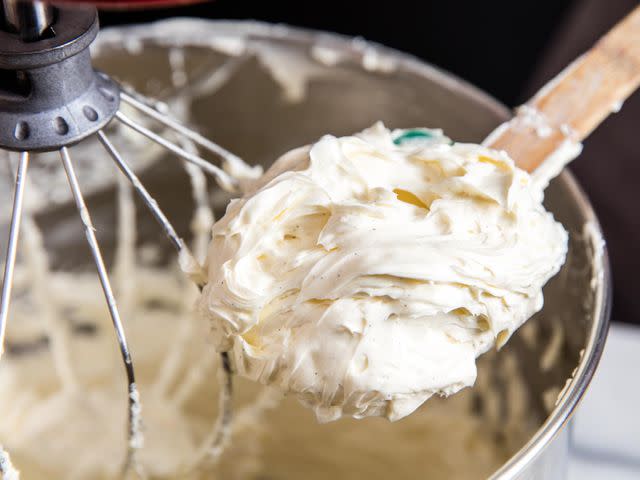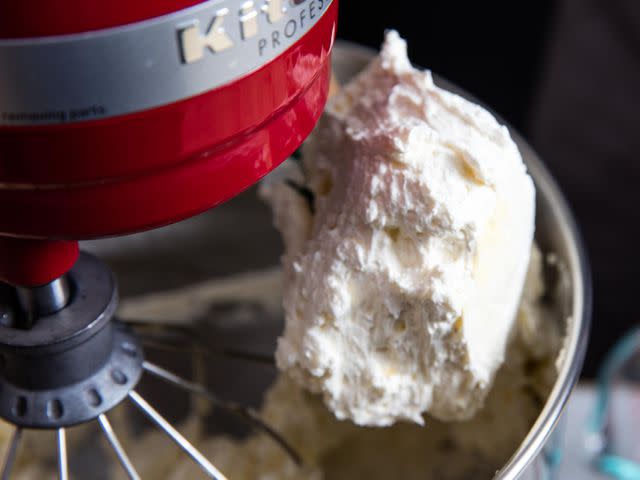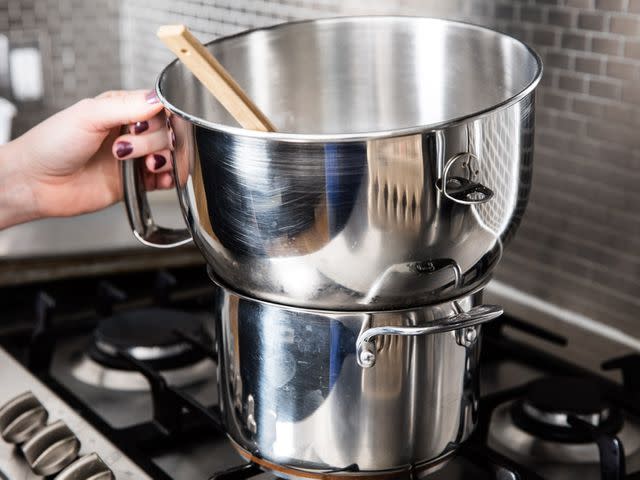How to Rescue Swiss Buttercream, No Matter the Problem
Whether it's a soupy disaster or a curdled mess, any batch of Swiss meringue buttercream can be easily saved.
If you start with a recipe for Swiss meringue buttercream like mine—one that includes some target temperatures for guidance—it's easy to get perfect results. But when recipes assume "room-temperature" butter means the same thing to everyone, perfection becomes a matter of experience or chance, hence the pervasive belief that Swiss meringue buttercream is a fickle thing that takes years of practice to get right. That's a myth I'd like to debunk once and for all.

Serious Eats / Vicky Wasik
Swiss meringue buttercream's behavior is ridiculously predictable and easy to master. All you need to know is this: As the frosting's temperature climbs above 75°F (24°C), its butter content will start melting, becoming softer and soupier with every passing degree. When the frosting's temperature drops below 69°F (21°C), its butter content will stiffen, bit by bit, until the frosting breaks into a curdled mess. But between those extremes, when the butter is pliable but cool, the frosting will be silky and light—perfect for spreading over your favorite cake.
Even when the frosting's temperature swings one way or another, there's no cause for dismay. Swiss meringue buttercream is a sturdy beast. Freeze it, melt it, over-mix it, break it; whatever happens, it'll always bounce back from disaster if you give it a little TLC. Here's how.
What to Do When Your Buttercream Is Soupy
Maybe it's because the meringue was made in a glass or ceramic mixing bowl that retained heat from the water bath. Maybe it's because the meringue wasn't cooled to 90°F (32°C). Maybe there's a summer heat wave and your tiny apartment kitchen doesn't have A/C. There are a million reasons why a Swiss buttercream may be too soft, and they all relate to heat. So, whether your buttercream is a veritable soup or just a touch runny, the answer is to cool it down.
If the buttercream is thin enough to run off a spoon, refrigerate the whole bowl for 20 minutes, just until the frosting begins to harden around the edges. The middle will still be soupy, but that's okay: The two will balance out in about four minutes as you whip them together on high speed. If the buttercream is simply loose or soft, like whipped cream, pop it in the fridge for just 10 minutes before re-whipping.
Remember, the goal is a soft and silky buttercream at about 73°F (23°C), give or take a degree.
What to Do When Your Buttercream Is Curdled
Maybe it's winter and the heat went out. Maybe the meringue whipped too long, cooling to well below 75°F (24°C). Maybe the butter came straight from the fridge. Maybe your buttercream was even frozen in advance, but didn't fully thaw. Doesn't matter why—if your Swiss meringue buttercream looks dense and greasy (or even tastes that way), it's simply too cold.

Serious Eats / Vicky Wasik
If the buttercream is lumpy or curdled, place the bowl over a steaming water bath.

Serious Eats / Vicky Wasik
Leave it there until the frosting has melted all around the edges, though most of it will still be a cold and solid mass in the center. Transfer to a stand mixer fitted with a whisk attachment, and start on low speed to prevent splashing; gradually increase to high and whip until homogeneous, about four minutes. The buttercream will turn glossy and light as it reaches 72°F (22°C).
If it still feels stiff and heavy, warm it over the water bath, just until you notice the first signs of melt, then whip until creamy and smooth.
That's... it. Everything you need to know about fixing a broken Swiss meringue buttercream.
Hypothetically, trouble could come from other causes (improperly measured ingredients, using a badly formulated recipe, miscalculating a half or double batch, going overboard with watery mix-ins like rum or fruit purée, et cetera), but nine times out of 10, the problem is temperature and nothing more.
So don't ever throw out a soupy or curdled batch of Swiss meringue buttercream. Just grab a digital thermometer, and you'll have the problem fixed in no time flat.
Get Recipe: Swiss Meringue Buttercream Recipe | BraveTart
May 2017
Read More
Read the original article on Serious Eats.

